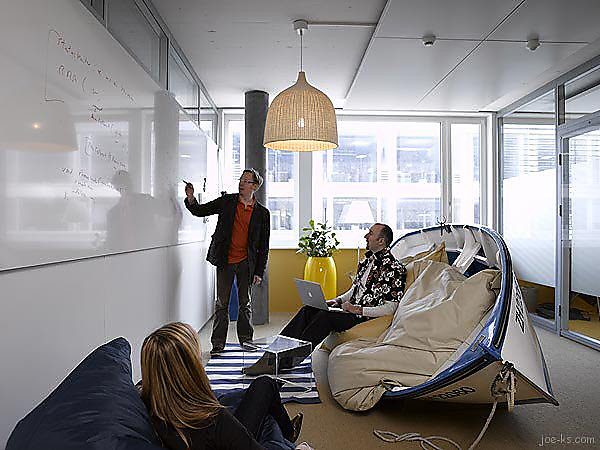Yesterday I went to visit a friend from college who works at a “social media” office here in Toronto (I am using the term social media because they made me sign a consent form and I’m not trying to get sued!). After meeting for lunch at a quaint little sandwich shop on Bay Street, we headed back to his office so he could give me a tour. Now, I had watched “The Internship” which is set at the Googleplex in California so I had a bit of an idea of what to expect from the environment. But seeing new age corporate offices on a TV screen and experiencing them firsthand are two completely different things. Experiencing it made me think about our ideas on classrooms of the future.
As we strolled through the offices, he showed me their games room, equipped with a pool table, arcade-style basketball hoops, ping-pong and the likes. We passed by “resting hubs” for employees who wanted to take a break (at any time in the day). I noticed what I would term “graffiti walls” and “graffiti columns” were people could scribe anything from words of wisdom to short notes. There were stick-up pads each titled something to the tune of, “I am thankful that…” at the top. In the middle of the day, during the middle of the workweek, it blew my mind to see a group of workers laughing as they played an impromptu game of improv in a lounge area. Employees whizzed around to get to places on scooters. Everyone was smiling, everyone seemed happy and most importantly, all were productive.
As I left, I couldn’t help but think about how this idea of the cutting edge corporate workplace breeds productivity. These companies, who are some of the most successful and innovative in history, are that way because of the environment they foster. These spaces are not your traditional workspaces that seek to eek out productivity by pushing their workers to the limits through placing them in tiny grey cubicles surrounded by manila painted walls. The environment of these places begets innovation. It is education’s turn to learn a thing or two from these new wave corporate workspaces.
Imagine a space where students weren’t shuffled off from room to room by the signaling of a bell. A place where students still had to be at school by a specific time and leave school at a specific time, but in between could spend their time in an environment where mental wellness was a priority. Of course, just like the employees at Google or Facebook, “quotas” would still remain precedent. Those employees all have deadlines and mandates to meet. But they are not micromanaged the way that most traditional businesses and all schools currently operate.
We want our schools to breed curious and innovative students but our environment shouts of the opposite. We sit children in rows on rows and instruct according to the minutes in the week, day or period, yet we hope that this type of instruction will breed innovation. Part of creating innovative and creative students is teaching content that will allow for it. But I think another part of fostering this capacity is in the very environment in which we force these students to learn. This is an area that often gets overlooked in discussions pertaining to education reform. If we want our students to think “outside the box”, we have to acknowledge the box that education currently sits in.
[share title=”Share this Post” facebook=”true” twitter=”true” google_plus=”true”]

